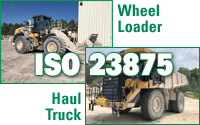
Initial installation and 8-month follow-up investigation of cab air-quality system and certification under ISO 23875
-
- Location: Aggregate Quarry
- Pilot machines:
- Cat 775G Haul Truck
- Cat 982M Wheel Loader
“I really feel from my ongoing conversations with the operators that this has been an asset to the machine’s operators in their alertness and ability to stay focused.”
|
ISO 23875 – Mining – Air quality control systems for operator enclosures – Performance requirements and test methods
ISO 23875 is an international standard that creates a consistent approach to designing, testing, operating, and maintaining operator enclosures with respect to air quality in the mining industry.
Adoption of the practices outlined in the standard protect personnel inside operator enclosure through:
-
- Maintaining safe levels of CO2
- Conducting routine performance testing of air quality control systems to maintain compliance, including testing cab pressure, operating CO2 concentration, and fresh and recirculation filtration effectiveness
- Performing preventative maintenance throughout the lifecycle of the cab
What problem does ISO 23875 solve?
-
- Reduce operator fatigue by maintaining CO2 at a low level
- Reduce potential dust exposures within the operator cab
- Ensure CO2 and dust are continuously managed through continuous cab pressurization, fresh air exchange, and real time monitoring capability
Haul Truck: ISO 23875 Performance After Installation

Cab air-quality system installed in haul truck included:
-
- RESPA® CF2 Powered
precleaner/pressurizer/HEPA filter intake air system - RESPA Advisor®+ Cab monitoring system for cab
pressure/CO2/alarms/data logging - (2) RESPA® FFX2 non powered HEPA recirculation filtration units
- RESPA® CF2 Powered
“Stays cleaner inside equipment. Operator states ‘air seems to be more crisp’ and he stated ‘he felt more comfortable throughout his 10 to 11 hour shift’.”
|
Following the installation of engineering controls and technology outlined above, performance testing was done in compliance with ISO 23875 and the following observations and test data have been recorded.
-
- CO2 test – 861 PPM after 15 minutes – PASS
- Requirement: CO2 concentration must be less than the ambient CO2 concentration plus 400 PPM.
- Ambient CO2 592 PPM plus 400 = 1092 PPM
- Dust decay test – 1 minute 18 seconds – PASS
- Requirement: decay must be under two minutes
- External system leakage – PASS
- Requirement is for dust concentration not to exceed 100 ug/m3
- Interior PM10 dust concentration Start of test 6.6 ug/m3
- Interior PM10 dust concentration at end of test 7.2 ug/m3
- Cab pressure – PASS
- Requirement: Minimum cab pressure 20 Pa, Maximum cab pressure 200 Pa
- RESPA only 31 Pa
- Low fan speed – 33 Pa
- Medium speed – 33 Pa
- High speed – 35 Pa
- CO2 test – 861 PPM after 15 minutes – PASS
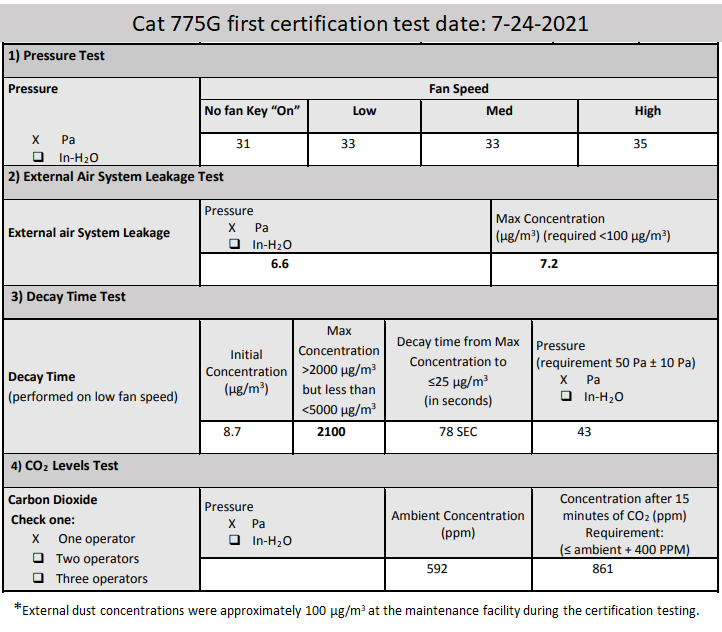
CO2 Level in Cat 775G Haul Truck During 4.98 hrs of Machine Operations
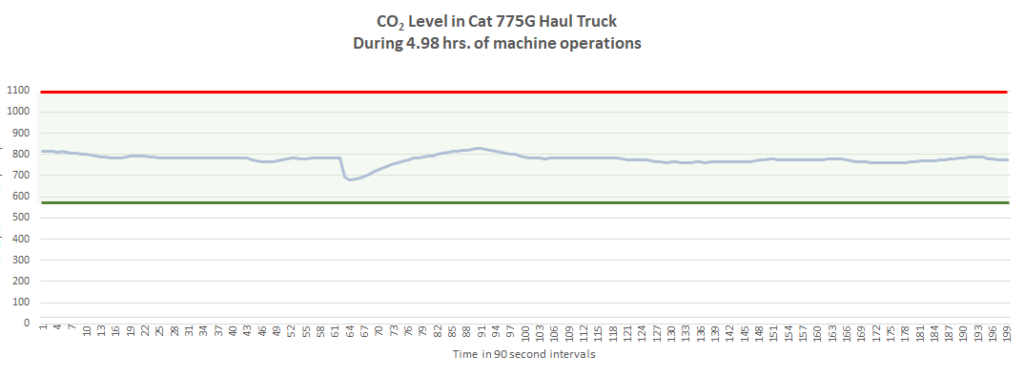
– Alarm level (set at ambient CO2 level plus 400 PPM (592 + 400 = 1092 ≈ 1100 PPM))
– Ambient CO2 level 592 PPM
– Safe operating area
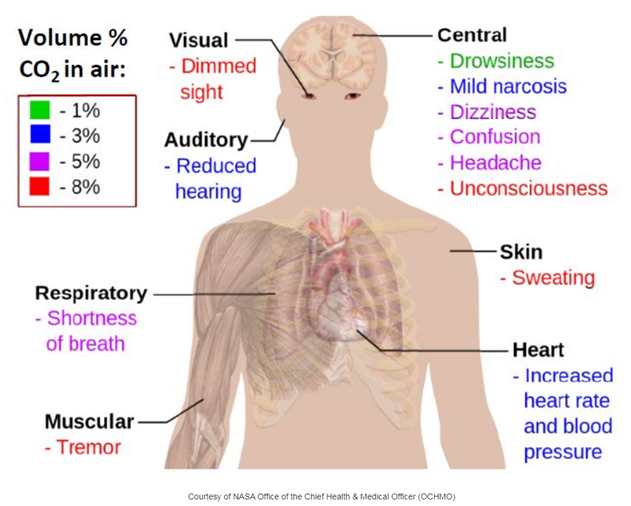
-
- 1% = 10,000 PPM
- According to the ACGIH, the Occupational Exposure Limit (OEL) for an eight-hour work shift is an average of 5000 PPM.
- Effects of too much CO2 include:
- At 1% volume in air:
- Drowsiness
- At 3% volume in air:
- Mild narcosis
- Reduced hearing
- Increased heart rate and blood pressure
- At 5% volume in air:
- Dizziness
- Confusion
- Headache
- Shortness of breath
- At 8% volume in air:
- Sweating
- Muscle tremors
- Dimmed sight
- Unconsciousness
- At 1% volume in air:
- 1% = 10,000 PPM
Haul Truck – ISO 23875 Performance ~8 Months After Installation
Following the installation of engineering controls and technology outlined on previously, performance testing was done in compliance with ISO 23875 eight months after the initial installation and immediately before the third Filter PM.
-
- CO2 test – 749 PPM after 15 minutes – PASS
- Requirement: CO2 concentration must be less than the ambient CO2 concentration plus 400 PPM.
- Ambient CO2 455 PPM plus 400 = 955 PPM
- Dust decay test – 1 minute 16 seconds – PASS
- Requirement: decay must be under two minutes
- External system leakage – PASS
- Requirement is for dust concentration not to exceed 100 ug/m3
- Interior PM10 dust concentration Start of test 3.7 ug/m3
- Interior PM10 dust concentration at end of test 3.9 ug/m3
- Cab pressure – PASS
- Requirement: Minimum cab pressure 20 Pa, Maximum cab pressure 200 Pa
- RESPA only – 23 Pa
- Low fan speed – 31 Pa
- Medium speed – 59 Pa
- High speed – 72 Pa
- CO2 test – 749 PPM after 15 minutes – PASS
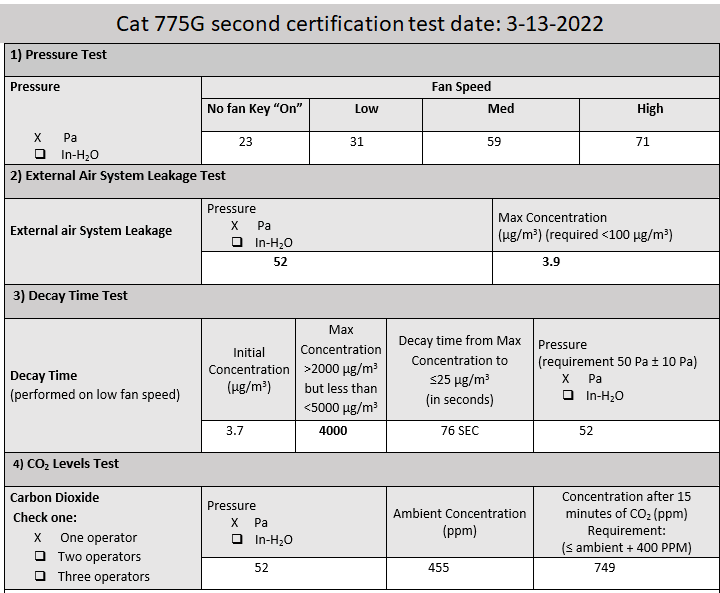
Wheel Loader – ISO 23875 Performance After Installation
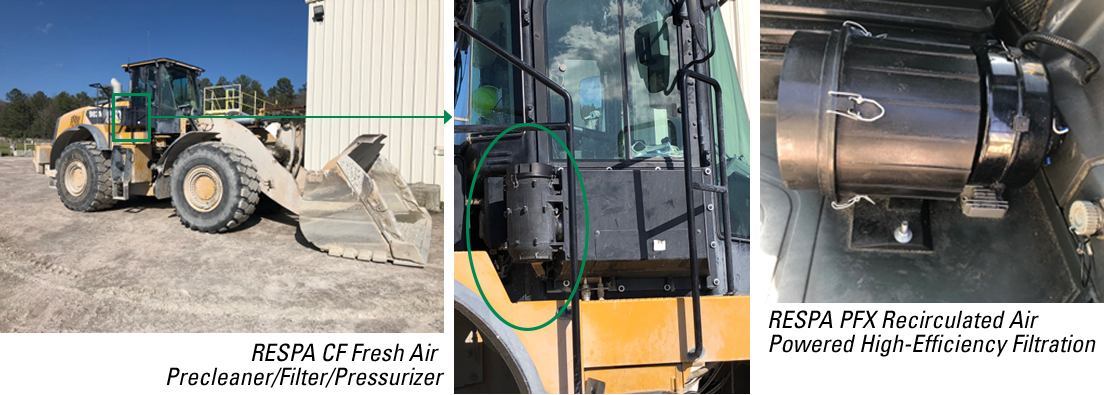
Cab air-quality system installed in wheel loader included:
-
- RESPA-PFX Powered HEPA recirculation filtration
- RESPA-CF Powered precleaner/pressurizer/HEPA filter intake air system
- RESPA Advisor+ Cab monitoring system for cab pressure/CO2/data logging
“Equipment stays cleaner inside. Machine operator states ‘air seems to be more fresh’. He has noticed his energy level throughout his 10 to 11 hour day seems more consistent not the peaks and valleys throughout the day.”
|
Following the installation of engineering controls and technology outlined on previous slides, performance testing was done in compliance with ISO 23875 and the following observations and test data have been recorded.
-
- CO2 Test – 846 PPM after 15 minutes – PASS
- Requirement: CO2 concentration must be less than the ambient CO2 concentration plus 400 PPM.
- Ambient CO2 628 PPM plus 400 = 1028 PPM
- CO2 test value 846 PPM
- Dust decay test – 1 minute 11 seconds – PASS
- Requirement: decay must be under two minutes
- External system leakage – PASS
- Requirement is for dust concentration not to exceed 100 ug/m3
- Interior PM10 dust concentration Start of test 12.4 ug/m3
- Interior PM10 dust concentration at end of test 23.7 ug/m3
- Cab pressure – Passed at no-fan and low fan speed; medium and high fan-speed pressure exceeded threshold
- Requirement: Minimum cab pressure 20 Pa, Maximum cab pressure 200 Pa
- RESPA-only 92 Pa
- Low fan speed – 194 Pa
- Medium speed – 312 Pa
- High speed – 368 Pa
- CO2 Test – 846 PPM after 15 minutes – PASS
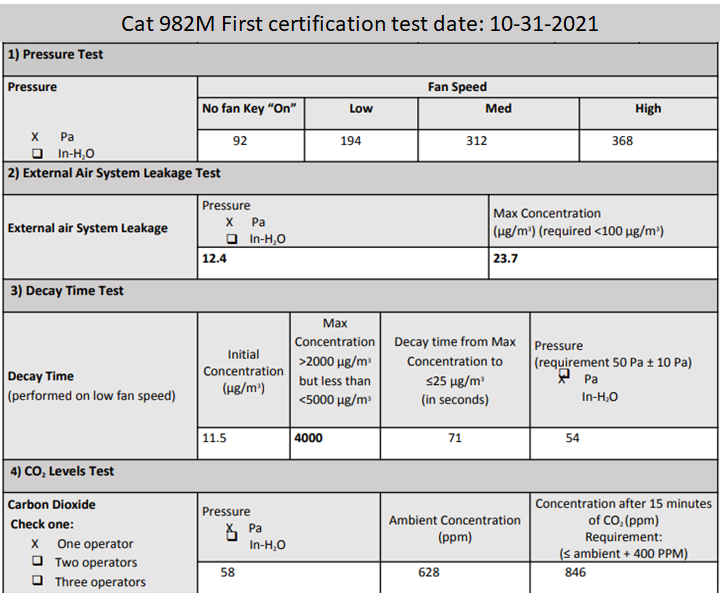
Wheel Loader – ISO 23875 Performance 8 Months After Installation
Following the installation of engineering controls and technology outlined on previous slides, performance testing was done in compliance with ISO 23875 eight months after the initial installation and immediately before the third filter PM.
-
- CO2 Test – 820 PPM after 15 minutes – PASS
- Requirement: CO2 concentration must be less than the ambient CO2 concentration plus 400 PPM.
- Ambient CO2 543 PPM plus 400 = 1043 PPM
- CO2 test value 820 PPM
- Dust decay test – 1 minute 18 seconds – PASS
- Requirement: decay must be under two minutes
- External system leakage – PASS
- Requirement is for dust concentration not to exceed 100 ug/m3
- Interior PM10 dust concentration Start of test 7.8 ug/m3
- Interior PM10 dust concentration at end of test 28.6 ug/m3
- Cab pressure – Passed at no-fan and low fan speed; medium and high fan-speed pressure exceeded threshold
- CO2 Test – 820 PPM after 15 minutes – PASS
- Requirement: Minimum cab pressure 20 Pa, Maximum cab pressure 200 Pa
- RESPA only 23 Pa
- Low fan speed – 115 Pa
- Medium speed – 226 Pa
- High speed – 240 Pa
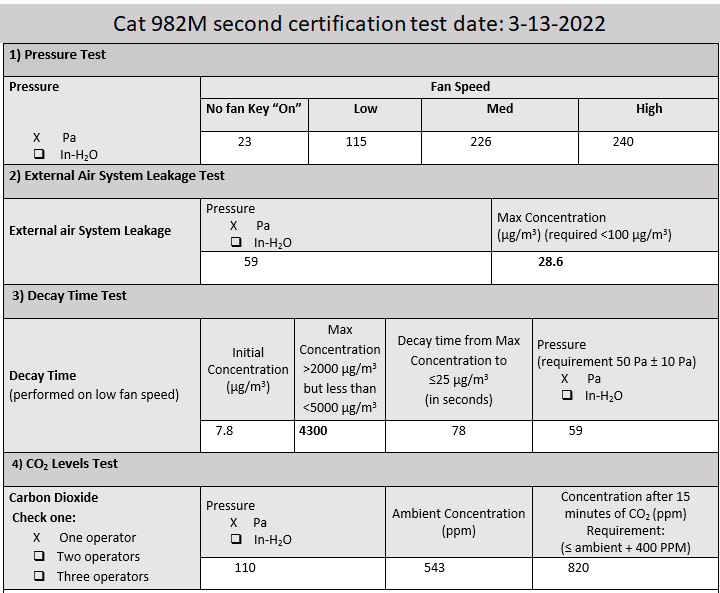
Wheel Loader CO2 Level During 6.35 hrs of Machine Operations
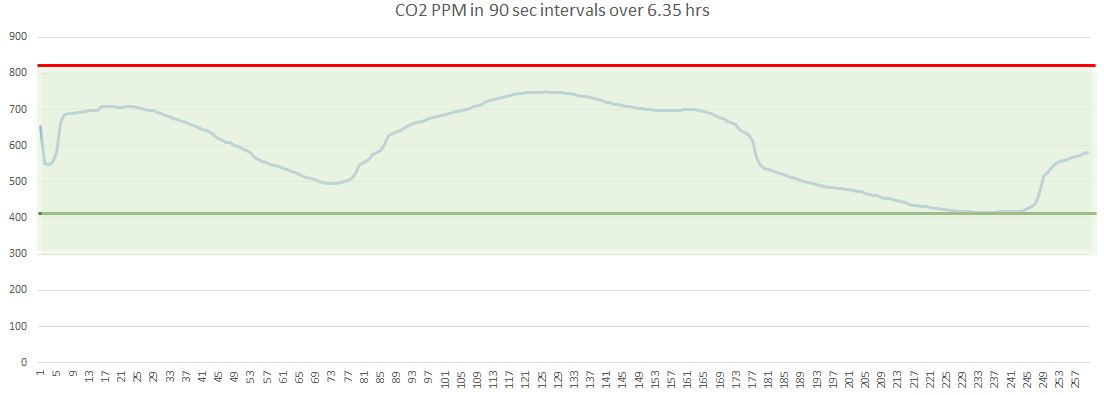
– Alarm level (set at ambient CO2 level plus 400 PPM (416 + 400 = 816 PPM)
– Ambient CO2 level 416 PPM
– Safe operating area
What is the technology and how does it work?
RESPA Advisor+ CO2 + Pressure Monitor
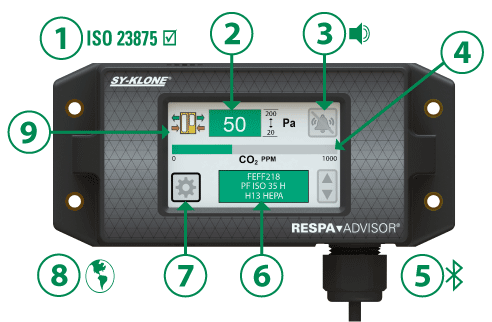
-
- ISO 23875-Compliant Monitor
Meets ISO 23875 performance requirement for real-time operator cab monitoring, including stringent CO2 sensor specifications. - Cab Pressurization
The monitor reports cab pressurization levels in real-time to support the machine operator’s maintenance of a controlled-air-quality cab environment. - Audible and Visual Alarms
Built-in alarms alert the operator when pressurization or CO2 levels go outside of the allowable threshold. - High-Quality CO2 Monitor
Not all CO2 sensors are created equal. The RESPA Advisor+ includes a nondispersive infrared sensor (NDIR), as specified in ISO 23875, to provide real-time CO2 data to alert operators when unsafe air quality conditions exist. - Download Data for Analysis
Gain insights into the operator cab environment with data logging at an interval you specify. Download the data via Bluetooth to the Smartphone App, allowing you to access and share data logs. - Filter Life Tracking
Take the guess work out of filter life, with manual filter tracking to ensure optimal filter life and performance. - Customizable Settings
Admin settings can be configured to suit your needs. Metric and imperial pressure units, high- and low-pressure thresholds, CO2 limits, alarm behavior, data sampling intervals for logging, and more. - Ready for Jobsites Worldwide
Symbol-based interface for ease of use for all users, regardless of native language, with metric and imperial units of measure.
- ISO 23875-Compliant Monitor
RESPA FFX2 Non-Powered High-Efficiency Recirculation Filtration
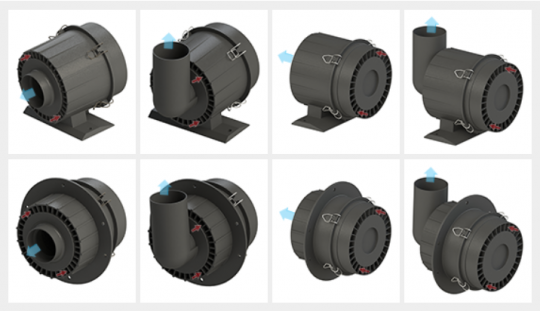
-
- The RESPA®-FFX2 is a high-efficiency recirculation filtration system, designed to complement the RESPA-CF2 powered fresh air system.
- Together, the two components satisfy the Best Practice Recommendations of the International Society of Environmental Enclosure Engineers (ISEEE) for high-efficiency fresh and recirculated air filtration.
- Designed for in cab installations and through the wall installations which allow for filters to be serviced from outside of cab.
- Includes all controls specified by the U.S. Occupational Safety and Health Administration (OSHA) silica regulation
- Complies with ISO 23875 Mining — Air quality control systems for operator enclosures — Performance requirements and test methods
- Radial Seal Technology provides 100% seal integrity; no by-pass risk as is common with panel filters.
- Low cost, versatile filter housing combines the need for high efficiency cab filtration and easy application.
- Can be installed in multiple unit configuration for higher volume airflows.
RESPA® CF2 High-Efficiency Precleaner/Filter/Cab Pressurizer
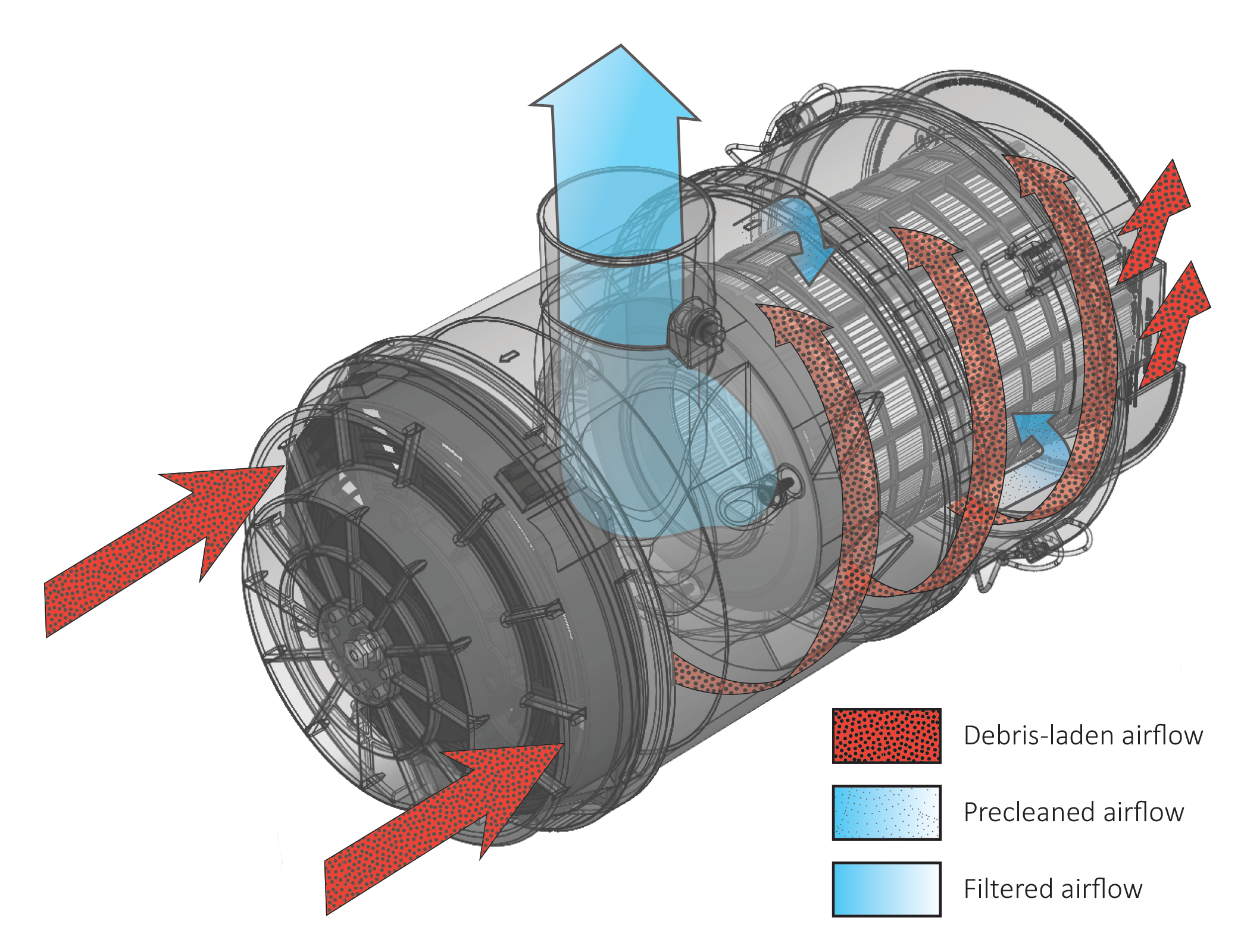
-
- Dirty air enters the unit where it is whipped into a vortex by the fan blades.
- Particulate enters a Sy-Klonic vortex and is whipped to the outer walls as cleaner air is pushed through the filter.
- The heaviest dirt, dust, and debris is ejected out of the system, leaving only the finest dust to be filtered out
- Air passes through a high-efficiency radial-seal filter, allowing only clean air to enter the HVAC mixing plenum
The separation and ejection of debris, and high-efficiency filtering, all of which precleans air, is The Sy-Klone Effect.
RadialSHIELD® High-Efficiency Filtration
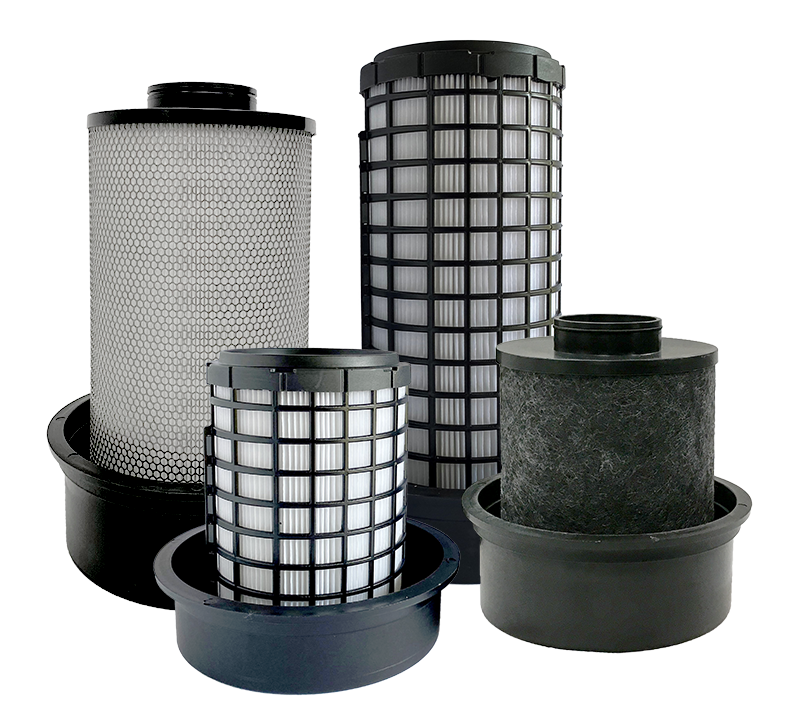
ISO 23875 Filter Performance Requirements
-
- Filter efficiency under ISO 23875 is classified under ISO 29463 and EN1822, which is based upon its efficiency at the most penetrating particle size (MPPS)
- Sy-Klone High-Efficiency Particulate Air filters (HEPA filters) meet ISO 23875 requirements
- 99.95% efficient at the MPPS (63 nanometers)
- Sy-Klone Efficient Particulate Air filters (EPA filters) meet ISO 23875 requirements
- Longer lasting and less fragile than HEPA media
- 99% efficient at 0.3 microns / ≥95% efficient at MPPS




